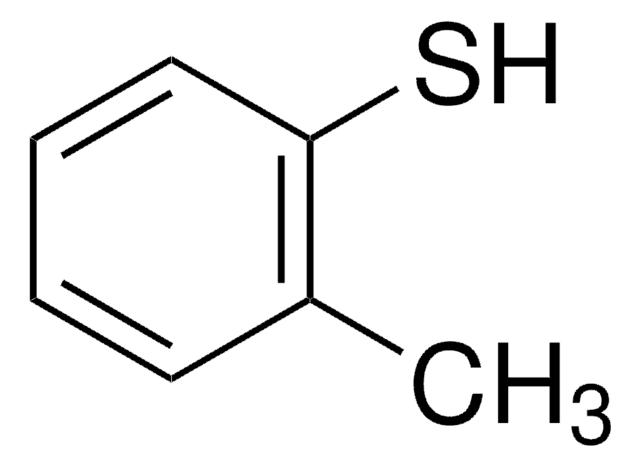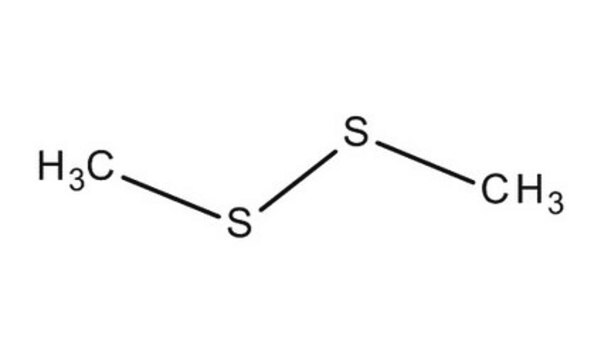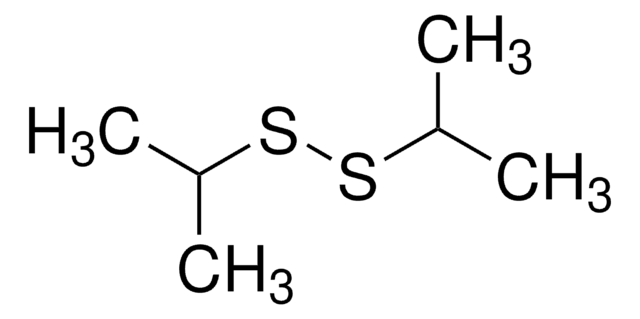W353604
Dimethyl disulfide
≥98%, FG
Sinônimo(s):
DMDS, Methyl disulfide
About This Item
Fragrance grade
Halal
Kosher
meets purity specifications of JECFA
Produtos recomendados
fonte biológica
synthetic
Nível de qualidade
grau
FG
Fragrance grade
Halal
Kosher
Agency
follows IFRA guidelines
meets purity specifications of JECFA
conformidade reg.
EU Regulation 1223/2009
EU Regulation 1334/2008 & 178/2002
FDA 21 CFR 172.515
densidade de vapor
3.24 (vs air)
pressão de vapor
22 mmHg ( 20 °C)
Ensaio
≥98%
temperatura de autoignição
>572 °F
Lim. expl.
16 %
índice de refração
n20/D 1.525 (lit.)
p.e.
109 °C (lit.)
pf
−85 °C (lit.)
densidade
1.046 g/mL at 25 °C (lit.)
aplicação(ões)
flavors and fragrances
Documentação
see Safety & Documentation for available documents
alérgeno alimentar
no known allergens
alérgeno de fragrância
no known allergens
Organoléptico
cabbage; onion; vegetable; sulfurous
cadeia de caracteres SMILES
CSSC
InChI
1S/C2H6S2/c1-3-4-2/h1-2H3
chave InChI
WQOXQRCZOLPYPM-UHFFFAOYSA-N
Procurando produtos similares? Visita Guia de comparação de produtos
Categorias relacionadas
Aplicação
- GC-IMS-Based Volatile Characteristic Analysis of Hypsizygus marmoreus Dried by Different Methods.: Dimethyl disulfide is used to enhance the aroma of some fresh seafood to, this shows that it can be used to optimize flavor (Lai et al., 2024).
Palavra indicadora
Danger
Frases de perigo
Declarações de precaução
Classificações de perigo
Acute Tox. 3 Inhalation - Acute Tox. 3 Oral - Aquatic Acute 1 - Aquatic Chronic 1 - Eye Irrit. 2 - Flam. Liq. 2 - Skin Sens. 1 - STOT SE 1 Inhalation - STOT SE 3
Órgãos-alvo
Central nervous system, Upper respiratory tract
Código de classe de armazenamento
3 - Flammable liquids
Classe de risco de água (WGK)
WGK 3
Ponto de fulgor (°F)
59.0 °F - closed cup
Ponto de fulgor (°C)
15 °C - closed cup
Equipamento de proteção individual
Eyeshields, Faceshields, Gloves, type ABEK (EN14387) respirator filter
Escolha uma das versões mais recentes:
Já possui este produto?
Encontre a documentação dos produtos que você adquiriu recentemente na biblioteca de documentos.
Os clientes também visualizaram
Nossa equipe de cientistas tem experiência em todas as áreas de pesquisa, incluindo Life Sciences, ciência de materiais, síntese química, cromatografia, química analítica e muitas outras.
Entre em contato com a assistência técnica













